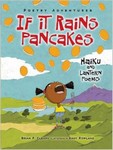 If it rains pancakes: Haiku and Lantern poems
If it rains pancakes: Haiku and Lantern poemsBrian P. Cleary
Illustrated by Andy Rowland
Poetry
For ages 6 to 8
Millbrook, 2014, 978-1-4677-4412-6
Haiku poems have been around for more than four hundred years. For many of those years westerners had no idea that these gem-like short poems existed. Haiku were not really appreciated and created by westerners until the early 1900’s. These days haiku are popular with children and adults alike. Every haiku has three lines, with the first line having five syllables. The second line has seven syllables, and the third line has five. Traditionally haiku poems focus on something that exists in nature, but in this book the author also give young readers poems about animals, food, school days and much more.
After reading twenty haiku poems, readers get to learn about lantern poems, which is another short poetry form that originated in Japan. The first line in these poems has just one word, which is always a noun and must have one syllable. The next four lines describe that noun with 2 syllables on the second line, three on the third, four on the fourth, and one syllable on the last line. After reading a description of what a lantern poem is, children can go on to read fifteen of these spare poems which look at bees, a cat, a hug, stars, a bed, dawn, and much more. Some of the poems are lyrical in nature, while others are amusing.
What is wonderful about this collection is that the author describes in detail what haiku and lantern poems are and then he gives us many examples of each poetry form. We are able to see how such poems are written, and some young readers may even be inspired to write some haiku and lantern poems of their own. As the author says, “Poetry’s not just a spectator sport.” Anyone can write poems that explore or describe things that they care about.
No comments:
Post a Comment